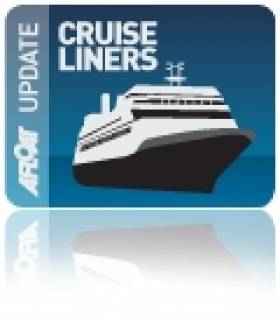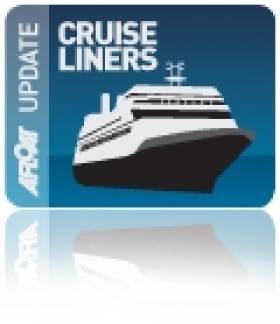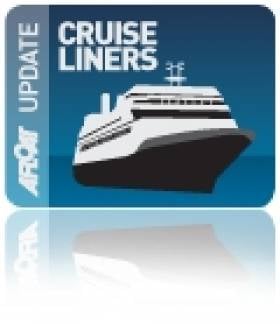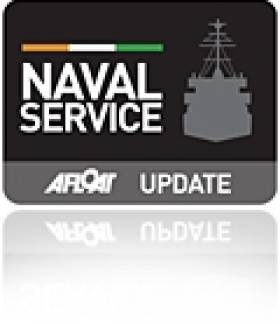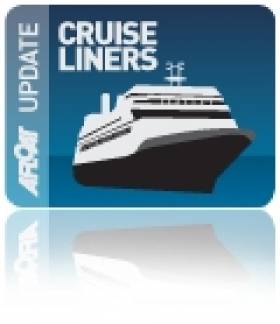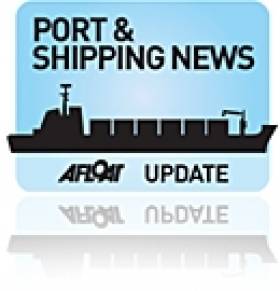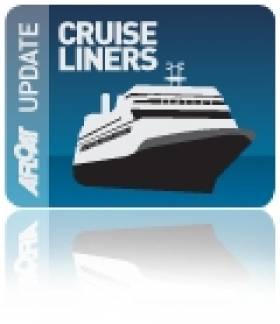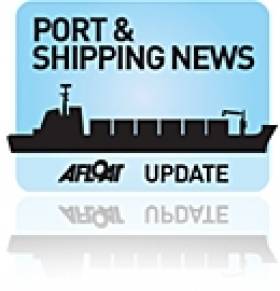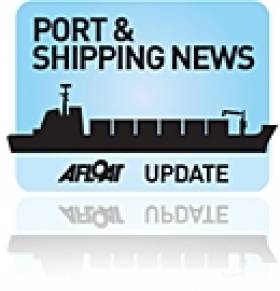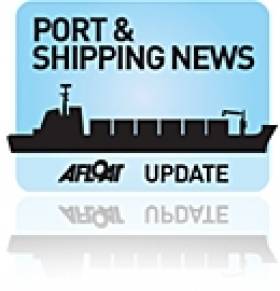Displaying items by tag: Dun Laoghaire Harbour
#MotorYacht - A striking looking Maltese flagged luxury charter motoryacht Lauren L, arrived this morning into Dublin Port to berth opposite the Poolbeg Yacht & Boat Club marina, writes Jehan Ashmore.
The 2,991 tonnes vessel built in Germany by the Cassens Werft shipyard, firstly began a career as a cruisehip. Under the name Sun Bay II, she made her debut season cruising in European waters and where she made a call to Dun Laoghaire Harbour, berthing alongside the ferry terminal at St. Michael's Wharf.
Under her current role, Lauren L as a charter yacht, she is able to host cocktail parties for up to 150 guests and overnight accommodation for 48 guests and all in the lap of luxury.
Features of the near 90m long vessel includes a conference room and centre, library, lido bar as well as a formal dining room plus a bow-mounted helicopter pad to shuttle guests to and fro.
Lauren L has a crew of 32 and she has worked in destinations such as the Cannes Film Festival. To charter the luxury motoryacht for a single week, this will set you back a mere €695,000, so get that lotto ticket!
She is approximately twice the size of the 52 passenger capacity cruisehip Quest, which called twice last year to Dun Laoghaire Harbour, where the port resumed in bringing this sector back after a break of more than a decade.
Next week, Dun Laoghaire Harbour looks forward in welcoming the giant 2,620 passenger liner Queen Mary 2. The Cunard Line 151,400 tonnes flagship will be making her maiden 'Dublin Bay' call with an anchorage call offshore of the harbour.
#LinerQM2 – A once in a lifetime opportunity to see fantastic close-up views of the giant Queen Mary 2 (QM2) during the liner's historic inaugural call off Dun Laoghaire Harbour are available with a Dublin Bay Cruises excursion, writes Jehan Ashmore.
The Dun Laoghaire based operator is running two special cruises to circle the 2,620 passenger QM2, the world's only liner during her 'anchorage' call next Thursday (16 May). Cruises depart from the East Pier (15.30 and 17.00) and head into Dublin Bay where the 151,400 tonnes Cunard Line 'flagship' will tower above the excursion boat St. Bridget.
Queen Mary 2 was built at the famous shipyard of Chantiers de l'Atlantique, St. Nazaire, France and cost €659m (US$800 million). The liner entered service in 2004 and to give a sense of her sheer size, she is 1,132 feet long, 236 feet high, 135 feet on the beam and has a draft of 32 feet.
Among the facilities, there are 15 restaurants and bars, five swimming pools, a casino, ballroom, theatre, spa-club, the only planetarium at sea and a 3D cinema. The Bermuda flagged liner which has 14 decks has a crew of 1,200.
She was named after the original Queen Mary which remains moored as a static floating hotel in Long Beach, California. Uniquely the Queen Mary 2 continues the tradition of the trans-Atlantic 'liner' which reflect a bygone era of the classic voyage between Southampton and New York.
Her call follows her predecessor the 70,000 tonnes Queen Elizabeth 2 (QE2), which twice made anchorage calls offshore of Dun Laoghaire more than a decade ago.
#LinerQueenMary2- The eagerly awaited visit of the world's only 'liner', Cunard Line's flagship Queen Mary 2 is now just over a week away to making her first ever visit to Dublin Bay with an 'anchorage' call off Dun Laoghaire Harbour, writes Jehan Ashmore. The liner arrives next Thursday, May 16th.
The significance of the call of Queen Mary 2 or 'QM2' as she is affectionately known will no doubt generate a major draw for onlookers when she arrives on the Dublin Bay horizon from a northerly direction around 06.00hrs.
Vantage points lining the East Pier, Scotsman's Bay and beyond will be condusive to witness the sheer size of the 151,400 tonnes giant vessel as she looms towards Dun Laoghaire.
The French built liner which cost €659m (US$800 million) is currently on a trans-Atlantic voyage and is bound for her homeport of Southampton. The liner represents a link to the past of the bygone era in travelling the Atlantic in complete luxury while capturing the essence of the classic sailing voyage experience to and from New York.
Facilities are both elegant and grand and where her 2,600 passengers have no less than 14 spacious decks with all the luxury one would expect with such liner prestige and historical pedigree.
Among the amenities guests can enjoy the Canyon Ranch spa-club, the only planetarium at sea and a 3D cinema.
Queen Mary 2 will be the highlight for the Dun Laoghaire Harbour Company as the passenger liner also marks the opening of the 2013 cruise season, and where such a large vessel will provide a much needed boost to regional tourism.
The port can also look forward to a dramatic increase this season as a further dozen or so cruise calls are scheduled to bring 30,000 passengers and crew to the port, a stark contrast to last year's return to this business sector with just two calls.
Another first will be the use of the purpose built cruise liner dock pontoon, when the QM2's tenders are expected to berth at the facility in the Coal Harbour.
The QM2's predecessor of only half her size the 70,000 tonnes Queen Elizabeth II (QE2) had made two anchorage calls offshore of Dun Laoghaire Harbour as did some other well known large cruiseships more than a decade ago.
In regards to Queen Mary 2, this will be her third call to Irish waters and as with the first visit, she too made an anchorage call offshore of Dunmore East in 2005. On her second call to Cobh in 2011 this involved berthing alongside the quay.
Naval Service ‘Flagship’ Visits Adopted Homeport of Flag Festival and Irish Diaspora Forum
#FlagshipsHomeport -With newcomer Dublin Bay Cruises running from the East Pier jetty in Dun Laoghaire Harbour, this led to the Naval Service 'flagship' L.E. Eithne (P31) having to take a different berth than usual at her adopted homeport, writes Jehan Ashmore.
The recent two-day call of L.E. Eithne saw the flagship make the unusual step of berthing at Carlisle Pier, the location chosen by the Dun Laoghaire Harbour Company for a proposed Irish International Diaspora Centre, a landmark building which is to form as a focal point of the port's Masterplan.
L.E. Eithne came alongside (berth No. 3) where the conventional ferry from Holyhead used to dock until 1996. To those of a different generation, memories will recall the 'mail' boats that docked also on the adjacent berth that faces the East Pier. Going back further was the era of the steam-packets that also plied the 60 nautical mile route to Anglesea.
Together these forms of vessels can trace the history of some 200 years of passenger services linking Ireland and Wales, and where Carlisle Pier was the embarkation point for thousands of Irish emigrants who set off to a begin a new life with our nearest neighbour and beyond.
As for the flagship the L.E. Eithne, she has represented the state proudly as a floating ambassador during her near 30 year career. She has visited many shores aboard, notably as the first Naval Service vessel to cross the Atlantic in 1986, where she sailed to the United States visiting Hamilton, New York, and Boston.
Such seafaring voyages that 'fly the flag' strengthen the ties between nations and heightens the importance of history, heritage and the cultural identity of flags and emblems.
On a related note the Genealogical Society of Ireland and the National Maritime Museum of Ireland, are to jointly host The Bratacha Festival of Flags and Emblems 2013 in the museum which is open to visitors free of charge on Friday 10 and Saturday 11 May.
Following the festival, the third Global Diaspora Forum, which is a celebration of the 70m Irish diaspora and is to be held in Dun Laoghaire on 14-15 May.
The forum has been held annually in Washington and, this year, it will run simultaneously in Washington and Dublin: primarily in the Killiney Castle Hotel and Dun Laoghaire County Hall.
#CruiseLiners – Sea Explorer, the small cruiseship which underwent a period of 'lay-up' in Dun Laoghaire Harbour as previously reported on Afloat.ie, is currently berthed in Barrow-in-Furness, having departed the Irish port last month, writes Jehan Ashmore.
Owned by Miami based International Shipping Partners (ISP), the 4,200 tonnes cruiseship with a 118 passenger capacity remained in Dun Laoghaire Harbour for just over a fortnight.
It was envisaged that the former Corinthian II which was renamed in Cadiz prior to her repositioning voyage to Dun Laoghaire Harbour, would at least remain in port until June before starting on a new cruise charter career.
Despite the relocation of Irish Sea port, Sea Explorer is currently in lay-up mode in the Cumbrian port, however she is due to start a new career during the summer on charter to Copenhagen based Albatross Travel. The Danish operator will be running cruises in Greenland. For several winter seasons, she will run for Polar Latitude on cruises in the Antarctic.
Also reported on Afloat.ie was the Waterford cruiseship season which started this month. Among the callers will be Sea Explorer which is due on 21 May and is to berth along the city-quays.
The call is to follow cruiseships that will have either taken anchorage or berthed at various locations throughout Waterford estuary.
#ShippingReview – Over the last fortnight, Jehan Ashmore has reported from the shipping scene, where Minister for Transport Leo Varadkar, launched the National Ports Policy which is to radically overhaul commercial ports and the transfer of 'regional' ports to local authorities.
Among the proposed regional ports is Dun Laoghaire, where the harbour which is in the middle of the town is expected to focus on tourism, cruise liners and marine leisure activity.
In regards to larger strategic ports, (noting Port of Cork development update) they are charged with leading the response to national capacity requirements, something that is long overdue because port capacity has not been matching growth in traffic for either unitised and non–unitised cargo.
The policy follows the launch of a 30–year masterplan for Dublin Port Company over a year ago and the launch of the Shannon Estuary masterplan announced in February.
Responding to the National Ports Policy, the Irish Ports Association (IPA) which is the representative body for the Irish ports sector and an affiliate of IBEC welcomed the publication which sets out the policy framework for the future development of the sector.
Amidst snow flurries and gusts up to 34 knots, the cargoship Blue Tune departed Dun Laoghaire Harbour having discharged the final round of fermentation tanks bound for Guinness's St. James's Gate Brewery in central Dublin.
The Antigua and Bermuda flagged vessel, was the third such ship to dock in Dun Laoghaire Harbour since mid-February and the return of cargo ships marks a trade not seen in the port for more than two decades.
#CruiseShips- A mini-luxury cruiseship Sea Explorer docked in Dun Laoghaire Harbour today, fortunately without passengers on board, as a very unseasonable Dublin Bay was battered by a heavy snow squall, writes Jehan Ashmore.
As the Sea Explorer approached Dun Laoghaire Harbour, the pilot cutter 'Liffey' which set out from Dublin Port came alongside to transfer a pilot aboard the 4,200 tonne vessel which was arriving on a passage from Cadiz.
Sea Explorer which has a passenger capacity for 116 passengers is to remain moored in the harbour albeit in a 'lay-up' mode in advance to taking up a European season with cruises starting in June from a temporary 'homeport'.
It is the norm for cruiseships to reposition between seasons and operating regions around the world, such as the Caribbean and Mediterranean and relocate to a designated homeport.
As previously reported on Afloat.ie, Dun Laoghaire Harbour is expected to receive up to 14 cruise calls this season, including the highlight call of Cunard Line's flagship liner 'QM2' on 16 May.
Also reported was yesterday's launch of the National Ports Policy where Minister for Transport, Leo Varadkar announced that Dun Laoghaire Harbour along with four other ports were classed as having 'regional significance'.
In the case of Dun Laoghaire Harbour, the development of the port is to be in line with local requirements focusing on tourism, cruise liners and marine leisure activity.
The ports are to be transferred to the control of local authorities in a move that will require legislation which may take up to 18 months to complete.
Meanwhile, Sea Explorer will be sharing the same quayside at the ferry terminal with the new Dublin Bay Cruises excursion vessel, St. Bridget.
On the adjacent berth is another vessel with a similar name to the cruiseship, that being the HSS Stena Explorer which operates the seasonal-only fast-craft ferry service to Holyhead.
Finally, the port has also been engaged in a return to cargsoships with the third batch of Guinness fermentation tanks, which were discharged from the Blue Tune on Monday. This final batch are bound for the St. James's Gate Brewery plant in Dublin.
#GuinnessTankship - The 86m cargsoship Blue Tune (2010/3,845grt) docked in Dun Laoghaire Harbour last night is undertood to have arrived with the final batch of fermentation tanks bound for the Guinness St. James Gate Brewery in central Dublin, writes Jehan Ashmore.
In heavy seas and strong south-easterly gale force winds, Blue Tune made the short passage across the bay from Dublin Port, having firstly delivered a part-cargo from Rotterdam.
Unlike the previous deliveries of the tanks to Dun Laoghaire Harbour taken on board two Dutch-flagged vessels, firstly by Myrte (2008/6,120grt) in February followed by Keizersborg (1996/6,142grt) last month, on this occasion Blue Tune is flagged under Antigua and Bermuda.
In addition Blue Tune is smaller compared to her Dutch counterparts in terms of tonnage size which would also place her as a 'coaster' compared to much larger vessels calling to Dublin Port and in this recent 'project' cargo trade to Dun Laoghaire Harbour.
As with the other Guinness related cargo-calls, Blue Tune berthed at the former 'mail' boat at Carlisle Pier, where six stainless steel fermentation tanks are due to be unloaded within the next few days.
Likewise forward tank transportation from Dun Laoghaire to the brewery which is undergoing a major €153m upgrade, is to be undertaken by road convoy and expected to be carried out in a night-time operation.
Second Round of Guinness Tanks Arrive
#GuinnessTanks – Another shipment of Guinness fermentation tanks arrived into Dun Laoghaire Harbour, where Sunday strollers watched the cargoship's arrival, from the length of the East Pier, writes Jehan Ashmore.
On this occasion, cargoship Keizersborg (1996/6,142grt) operated by Dutch owners Wagonborg Shipping, berthed at Carlisle Pier. This is the second delivery of the 'project' cargo, with another batch due of the stainless steel cylinders, each weighing 30 tons.
They are bound for St. James's Gate Brewery, where the plant is undergoing a major upgrade costing €153m.
As previously reported, the first shipment was transported on board Myrte (2008/6,120grt) which too had sailed directly from the same Dutch port.
Also in port was the HSS Stena Explorer, which after the cargoship's docking, departed for Holyhead, so to complete the return leg of the daily operated single round-trip service.
Again ‘Tank’ Goodness for Guinness
#GuinnessTanks – More than a week after cargoship Myrte docked in Dun Laoghaire Harbour, the massive fermentation tanks were yesterday transported in a nighttime convoy to the Guinness St. James's Gate Brewery in Dublin, writes Jehan Ashmore.
Another shipment is scheduled to arrive in the harbour towards the end of this weekend and also from Rotterdam. On this occasion, cargoship Keizersborg (1996/6,142grt) operated by Dutch owners Wagonborg Shipping, will be bringing in the second of three batches of the gleaming stainless steel cylinders.
Each of the 30 ton cylinders measure 22m long x 6.6m wide and 5.4m in height and some of them are capable of holding just under 1m pints!
As for the 122m long Myrte (2008/6,120grt) she took the honour as the first commercial vessel, excluding the fastcraft HSS Stena Explorer, to call to the harbour with a consignment of cargo, not seen since the early 1990's.
During that timeframe, the Danish flagged reefer Nordland Saga (1989/2,469grt), which then was a relative newbuild, had also berthed alongside Carlisle Pier.
The vessel registered in Frederickshavn differed to the 'Guinness' project cargo carrying vessels, in that she was fitted with deck-mounted cranes. As such mobile road cranes will again be deployed in the task of unloading the giant tanks onto the Carlisle Pier, where in recent years the former mailboat ferry terminal was demolished.
Carlisle Pier to date has served at times as storage space for yachts and currently has car-parking facilities, yet there are plans to build a landmark Diaspora Centre as part of the harbour's 'master plan'.



























